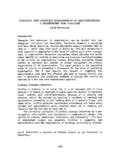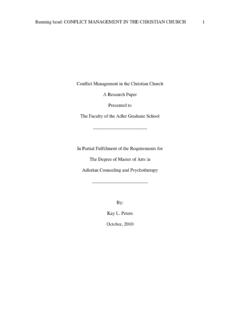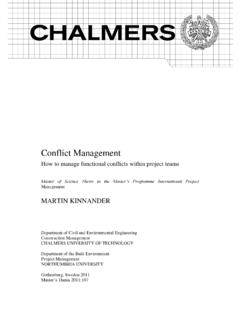Transcription of Indigenous conflict resolution in Africa - africavenir.org
1 Indigenous conflict resolution in Africa by Birgit Brock-Utne University of Oslo A draft presented to the week-end seminar on Indigenous solutions to conflicts held at the University of Oslo, Institute for Educational Research 23 24 of February 2001. So if Africa has to put the falling apart together , her original values must be re-visited. (Bob-Manuel, 2000: 10) It is now wide knowledge that Africa profiles the highest statistics of violent conflicts in the world. For years the treatment of conflicts in Africa involving national armies revolved around conventional mechanisms that have excluded the traditional approaches that are, according to Ofuho (1999) now in grater demand in the contemporary world, particularly in Africa . Ofuho (1999) in his paper to the All- Africa Conference on African Principles of conflict resolution and Reconciliation which was held from the 8th until the 12th of November 1999 in Addis Ababa, Ethiopia brings to light the experiences of grassroot peace-making efforts among the communities of the Kidepo Valley of Eastern Equatoria.
2 Kidepo is a big forest that starts from Karenga Hills in the north-east of the border with Uganda and extends deep into South Sudan. The people living along both divides of the valley regard Kidepo as a major asset in terms of both water and grazing resources, particularly during the dry season. It is worth pointing out that communities of the region under study have lived in hostility and co-existence for years and their conflicts have just recently picked up intolerable proportions due to the proliferation of modern weapons. The common source of conflict in the Kidepo Valley is cattle rustling. Cattle herds are the main source of income. Cattle can be sold in exchange for other commodities. A cow is like a modern account in the bank. A cow is payable as 2dowry in marriage negotiations or used in exchange for grain during hunger situations. Cattle are used as a source of milk, beef and cow dung mixed with mud is used for mud-slinging the walls of the huts for shelter.
3 Cattle are a highly regarded asset and each community believes that all the cattle of the world belong to them by divine right. They also claim that each of them is bestowed with the divine right to retrieve by stealth or armed force all cattle that neighbours possess or which each ethnic group might claim to be their own. In the Kidepo Valley, cattle rustling is mainly carried out by a group of men widely known as mojirimoit. It is only after a group of mojirimoit from neigboring communities have raided another community's cattle that responses to such incidences have led to conflict . Initially, all people who own cattle in the region used ordinary spears and arrows for protection of their cattle against rustlers. With the proliferation of light arms, such methods of defence have now been overtaken, and almost all cattle owners have now acquired deadly automatic rifles. The Karamoja and Dodos of Uganda have been prominent notorious cattle rustlers even across borders into Kenya and South Sudan.
4 These communities have often raided each others cattle but often resolved their disputes at the community level without much government or NGO involvement. Thus traditional approaches to reconciliation and conflict resolution existed among these communities from time immemorial. Since the beginning of life in Kidepo Valley, there have been as many attempts and practices of peace-making as there have been wars over resources in the region. Each member group of the communities often began their attempts of peace-making by first identifying the rote causes of the problem. Most of the problems occurred due to revenge for death previously committed over cattle rustling or during fighting over grazing and water resource areas in the Kidepo Valley. Once the problems are identified, communities convene meetings that may last two to three days in isolation in some forest where they deliberated 3over them and resolved them. But for such meetings to bear fruit, the role of what may be called opinion leaders and council of elders is crucial.
5 These elders have gained their authoritative influence through wisdom and experience. What must also be keenly noted by conventional mechanisms is the salience of traditional practices such as the use of rituals, symbols and interpretation of myths to bring conflicts to an end. These include the identification of a particular type of cattle and/or goat that must be sacrificed to cleanse away the evils of conflict from society. Another effective way of grass-root peacemaking in this valley is the use of curse by elders to deter the young mojirimots from continuos raids. The curse of elders is believed to lead to mysterious death. The word of elders are bitter and those who have caused troubles often vanish from society. Ofuho in his paper exposes factual stories about the conflict , highlights the use of symbols and interpretation of myths to resolve them. All these constitute practices of peacemaking, now fashionably termed "grass-root peacemaking" that have for years been used to contain cattle rustling in this region Lanek (1999) presented a paper he called:" 'Mato Oput', the drinking of Bitter Herb" to the All- Africa Conference on African Principles of conflict resolution and Reconciliation which was held from the 8th until the 12th of November 1999 in Addis Ababa, Ethiopia.
6 He is in this paper concerned with integrating Indigenous approaches with national and international mechanisms for conflict resolution and reconciliation. He also contrasts the Indigenous approaches, here especially the Acholi approach, with the western legal ones. Western legal approach emphasises establishing guilt and executing retribution and punishment without reference to the victim or the wider families or future reincorporation of the offender into the community. Physical and material penalties and use of force, including costly prisons, provide the sanctions against 4offending. Western legal approaches are adversarial and evidence must be direct and specific. The process, according to Lanek, effectively encourages the accused to deny responsibility while the Acholi method of peace, conflict resolution and reconciliation are co-operative and can be indirect and circumstantial which does effectively encourage the accused to admit responsibility.
7 He tells that the Acholi, a Luo speaking tribe occupying northern Uganda, for generations has used Mato Oput as a means of reconciliation within the context of their tradition. The Acholi believe in leadership through consensus, allowing everyone in their localised clans to have a voice while the traditional head of each clan rules by consent. A major function of the traditional chiefs is to act as arbitrators and reconcilers when disputes occur in order to restore peace and maintain harmonious relations between families and clans. The reconciliation process he describes is called the "Mato Oput" process (Mato Oput - an Acholi vernacular meaning drinking the herb of the Oput tree) because it ends in a significant ceremony of "Mato Oput", the traditional drinking of a bitter herb of the Oput tree. Mato Oput is not a happy ceremony, the mood of all present expresses the seriousness of the occasion. The process involves: the guilty acknowledging responsibility, the guilty repenting, the guilty asking for forgiveness the guilty paying compensation the guilty being reconciled with the victim's family through sharing the bitter drink - Mato Oput The bitter drink has no medicinal effect.
8 It only symbolises the psychological bitterness that prevailed in the minds of the parties in conflict situation The Mato Oput process covers offences across the board 5 In the publication announcing their Third Three-Year Programme 1995-97 AALAE (African Association for Literacy and Adult Education) makes an outline of the activities in the field of peace education that it wants to undertake in the three years to come. They also emphasize: "For this programme to attain its goals and objectives it is imperative to undertake in-depth research into the African concepts of conflict , as well as the African methods, techniques and processes of conflict prevention, management and resolution " (AALAE, 1994: 19) The Ugandian researcher Dani (1997) mentions that the recent collapse of the Somali nation-state and the reversion to the post-traditional method of social and political organisation in northern Somaliland have shown how dynamic some of the old systems are.
9 The restoration of the gurtii system of Clan Elders who intervene to settle conflicts and mediate between the hostilities of the different warlords have helped to maintain a semblance of order and stability in an otherwise hostile environment created by social relations and politics of modernity. The dia-system of compensation which in the old days was based on bloody compensation and revenge, is undergoing transformation while also providing a reference point for the reorganisation of the Somali society and conflict resolution and conflict management . In her term paper written for the course: Culture of Peace and Education taught at the European Peace University in Stadtschlaining Austria in the fall of 2000 Ineba Bob-Manuel from Nigeria is concerned about the fact that for more than a decade, and especially since the end of the cold war Africa has been torn apart by extremely intense conflicts which have resulted in thousands of deaths, and the internal displacement of millions of civilians.
10 She notes that the use of western methods of conflict resolution has failed. Peacekeeping operations, 6which have been conducted in the last few years under the auspices of the United Nations, have allowed for the establishment of peaceful processes only in very few countries, for example, Mozambique. More often than not they have been resounding failures, recent examples are: Somalia, Rwanda and Angola. This, she claims, is mostly because the political, military and sociological realities of these countries were not fully appreciated and comprehended. Today s predominant pattern of conflict in Africa is proving resistant to the available and accepted tools of conflict management . What Bob-Manuel sees needed is a new range of flexible and adaptable instruments that can take the more subjective, complex and deep-rooted needs and interests that underpin these conflicts into account. Special attention should be given to the valuable contributions from Africa .









